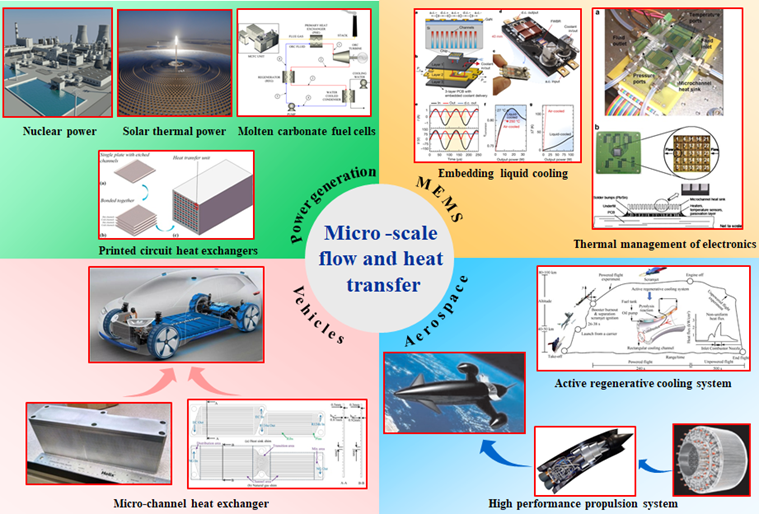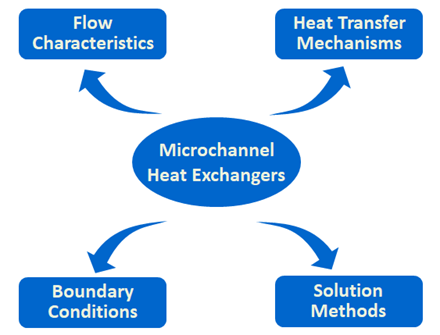
| Version | Summary | Created by | Modification | Content Size | Created at | Operation |
|---|---|---|---|---|---|---|
| 1 | Junqiang Zhang | -- | 1416 | 2023-08-02 14:47:48 | | | |
| 2 | Jason Zhu | -1 word(s) | 1415 | 2023-08-03 03:14:04 | | |
Video Upload Options
Continuously improving heat transfer efficiency is one of the important goals in the energy field. Compact heat exchangers characterized by microscale flow and heat transfer have successfully provided solutions for this purpose. However, as the characteristic scale of the channels decreases, the flow and heat transfer characteristics may differ from those at the conventional scale. When considering the influence of scale effects and changes in special fluid properties, the flow and heat transfer process becomes more complex. The conclusions of the relevant studies have not been unified, and there are even disagreements in some aspects. Therefore, further research is needed to obtain a sufficient understanding of flow structure and heat transfer mechanisms in microchannels. There are a lot of research about microscale flow and heat transfer, focusing on the flow and heat transfer mechanisms in microchannels, which is elaborated into the following two perspectives: one is the microscale single-phase flow and heat transfer that only considers the influence of scale effects, the other is the special heat transfer phenomena brought about by the coupling of microscale flow with special fluids (fluid with phase change (pseudophase change)). The microscale flow and heat transfer mechanisms under the influence of multiple factors, including scale effects (such as rarefaction, surface roughness, axial heat conduction, and compressibility) and special fluids, are investigated, which can meet the specific needs for the design of various microscale heat exchangers.
1. Introduction
The escalating energy demand has led to a gradual increase in resource scarcity and environmental degradation. Consequently, policymakers and regulators in many countries have opted to prioritize the enhancement of energy conversion efficiency and the restructuring of energy distribution. This has resulted in a surge of research interest in improving the efficiency of heat engines and heat exchangers [1]. In particular, compact heat exchangers are gradually replacing traditional heat exchangers, which can ensure efficient heat exchange tasks under more stringent space and weight constraints. Compact heat exchangers are usually composed of micro/small heat exchange units or microscale channels. Compared to conventional large-scale channels, they have an extremely high surface area-to-volume ratio and several orders of magnitude higher heat transfer performance [2]. Compact heat exchangers have become the preferred choice in many practical applications. With the improvement of manufacturing technology and heat transfer enhancement technology, various new types of microchannel heat exchanger configurations have been proposed and widely applied in many fields, as shown in Figure 1, including nuclear energy [3][4], solar thermal [5], molten salt fuel cells [6][7], microelectronic micro-mechanical systems [8][9], automotive cooling systems [10][11], aerospace (active regenerative cooling systems, precooled propulsion systems, etc.) [12][13][14][15][16][17][18][19][20][21], and so on.

Figure 1. Applications of microscale flow and heat transfer in industrial fields

Figure 2. Classification diagram of microchannel heat exchangers.
2. Complex Flow and Heat Transfer Characteristics
Here systematically reviews the microscale flow and heat transfer research, focusing on the flow and heat transfer mechanisms in microchannels. The microscale flow and heat transfer mechanisms under the influence of multiple factors, including scale effects (such as rarefaction, surface roughness, axial heat conduction, and compressibility) and special fluids, are investigated, which can meet the specific needs for the design of various microscale heat exchangers. The results can be summarized as follows:
(1)The current research on flow and heat transfer characteristics in the microchannel can be divided into two categories: one is the microscale single-phase flow and heat transfer, which excludes the effect of fluid physical properties changes and focuses on the mechanism of the scale effects due to the reduction of the channel size. The other is the application of special fluids (fluid with phase change (pseudophase change)) in microchannels, which brings about the coupling of the scale effects with the change of the physical properties, and the overall heat transfer performance is further enhanced. However, most of the studies in this field have focused on the flow and heat transfer characteristics of special fluids in microchannels, rather than on the scale effects in particular.
(2) For the flow and heat transfer mechanisms of single-phase fluid in microchannels, it is first necessary to determine whether the flow satisfies the continuity assumption by the Kn number. If Kn<0.001, the flow is regarded as continuous. Although the basic equations and physical laws at conventional scales are applicable, scale effects (rarefaction effects, surface roughness, wall axial heat conduction, compressibility, etc.) must be taken into account, which is an important reason for the deviation of macroscopic classical flow and heat transfer theories in microchannel single-phase flow. If Kn>0.001, the assumption of continuity no longer holds, and rarefaction effects become significant. It is necessary to modify the boundary conditions (slip velocity, temperature jump) or apply molecular dynamics theory to solve the difference between classical continuum flow and molecular transport flow.
(3) The flow boiling heat transfer mechanism in microchannels is very different from that in conventional channels. In the boiling heat transfer process of microchannels, the development of bubbles goes through a series of dynamic processes that include bubble nucleation, growth, departure, and movement along the flow direction. However, the development patterns of conventional scale flow patterns are often unable to predict flow pattern transitions in microchannels. It is necessary to consider more influencing factors, such as bubble constraints, channel size, and shape effects. The above factors play an important role in flow heat transfer characteristics, as well as various flow instabilities.
(4) For the flow and heat transfer mechanism of the fluid with pseudophase change in microscale channels, the significant change of physical properties in the transcritical process leads to dramatic velocity fluctuations, which directly affects the turbulent burst behavior of the flow field (ejection event Q2 and sweep event Q4). Buoyancy and thermal acceleration are considered as indirect effects on the flow field, which may lead to the attenuation of turbulence intensity and reduce the ability of turbulent heat transfer. In addition, the mechanisms of different heat transfer modes for supercritical pressure fluids in microchannels have not been unified. In particular, how to maximize the performance of heat transfer enhancement while effectively avoiding heat transfer deterioration remains to be further studied.
References
- Wang, C.; Lu, Q.; Liu, Y.; Huang, H.; Sun, J. Progressive review of heat transfer enhancement technologies in 2010–2020. Sustain. Energy Technol. Assess. 2023, 56, 103121.
- Naqiuddin, N.H.; Saw, L.H.; Yew, M.C.; Yusof, F.; Ng, T.C.; Yew, M.K. Overview of micro-channel design for high heat flux application. Renew. Sustain. Energy Rev. 2018, 82, 901–914.
- Bartel, N.; Chen, M.; Utgikar, V.P.; Sun, X.; Kim, I.H.; Christensen, R.; Sabharwall, P. Comparative analysis of compact heat exchangers for application as the intermediate heat exchanger for advanced nuclear reactors. Ann. Nucl. Energy 2015, 81, 143–149.
- Gkountas, A.A.; Stamatelos, A.M.; Kalfas, A.I. Recuperators investigation for high temperature supercritical carbon dioxide power generation cycles. Appl. Therm. Eng. 2017, 125, 1094–1102.
- Han, Z.; Guo, J.; Huai, X. Theoretical analysis of a novel PCHE with enhanced rib structures for high-power supercritical CO2 Brayton cycle system based on solar energy. Energy 2023, 270, 126928.
- Sabharwall, P.; Clark, D.; Glazoff, M.; Zheng, G.; Sridharan, K.; Anderson, M. Advanced heat exchanger development for molten salts. Nucl. Eng. Des. 2014, 280, 42–56.
- Di Ronco, A.; Cammi, A.; Lorenzi, S. Preliminary analysis and design of the heat exchangers for the Molten Salt Fast Reactor. Nucl. Eng. Technol. 2020, 52, 51–58.
- Shah, R.K. Advances in Science and Technology of Compact Heat Exchangers. Heat Transf. Eng. 2006, 27, 3–22.
- Mathew, B.; Jakub-Wood, B.; Ogbonnaya, E.; Weiss, L. Investigation of a MEMS-based capillary heat exchanger for thermal harvesting. Int. J. Heat Mass Transf. 2013, 58, 492–502.
- Park, H.S.; Pham, N.H. Design of conformal cooling channels for an automotive part. Int. J. Automot. Technol. 2009, 10, 87–93.
- Hussein, A.M.; Bakar, R.A.; Kadirgama, K. Study of forced convection nanofluid heat transfer in the automotive cooling system. Case Stud. Therm. Eng. 2014, 2, 50–61.
- Xie, G.; Xu, X.; Lei, X.; Li, Z.; Li, Y.; Sunden, B. Heat transfer behaviors of some supercritical fluids: A review. Chin. J. Aeronaut. 2022, 35, 290–306.
- Strumpf, H. Development of a microchannel heat exchanger for aerospace applications. In Proceedings of the ASME 2012 10th International Conference on Nanochannels, Microchannels, and Minichannels, Rio Grande, PR, USA, 8–12 July 2012.
- Li, H.; Liu, H.; Zou, Z. Experimental study and performance analysis of high-performance micro-channel heat exchanger for hypersonic precooled aero-engine. Appl. Therm. Eng. 2021, 182, 116108.
- Chen, Y.; Zou, Z.; Liu, H.; Li, H.; Li, H.; Zhao, R. Verification at Mach 4 heat conditions of an annular microtube-typed precooler for hypersonic precooled engines. Appl. Therm. Eng. 2022, 201, 117742.
- Li, H.; Zou, Z.; Liu, Y. A refined design method for precoolers with consideration of multi-parameter variations based on low-dimensional analysis. Chin. J. Aeronaut. 2022, 35, 329–344.
- Zou, Z.; Wang, Y.; Du, P.; Yao, L.; Yang, S.; Zhang, W.; Luo, J. A novel simplified precooled airbreathing engine cycle: Thermodynamic performance and control law. Energy Convers. Manag. 2022, 258, 115472.
- Zou, Z.; Wang, Y.; Li, H.; Chen, Y.; Yao, L.; Li, H.; Liu, H. Thermal-hydraulic characteristics of a PCHE with zigzag microchannel for hypersonic precooled aero-engines: An experimental study. Exp. Heat Transf. 2022; ahead-of-print.
- Li, H.; Zou, Z.; Chen, Y.; Du, P.; Fu, C.; Wang, Y. Experimental insights into thermal performance of a microtube precooler with drastic coolant properties variation and precooling impacts on turbojet engine operation. Energy 2023, 278, 127916.
- Fu, C.; Zou, Z.; Liu, H.; Wang, Y.; He, X. Experimental study on the flow and heat transfer mechanism of the pre-cooler in the hypersonic aeroengine. In Proceedings of the 21st AIAA International Space Planes and Hypersonics Technologies Conference, Xiamen, China, 6–9 March 2017.
- Lee, H.; Ma, S.; Chen, Y.; Zou, Z.; Liu, H. Experimental study on compact heat exchanger for hypersonic aero-engine. In Proceedings of the International Space Planes and Hypersonic Systems and Technologies Conferences, Xiamen, China, 6–9 March 2017.
- Poiseuille, J.M.L. Experimental Investigations Upon the Flow of Liquids in Tubes of Very Small Diameters; 1846; pp. 433–545.
- Knudsen, M. DieGesetze der Molekularströmung und der inneren Reibungsströmung der Gase durch Röhren. Ann. Phys. 1909, 28, 75–130.
- Gaede, W. Die äussere Reibung der Gase. Ann. Phys. 1913, 346, 289–336.
- Tuckerman, D.B.; Pease, R.F.W. High-performance heat sinking for VLSI. IEEE Electron Dev. Lett. 1981, 2, 126–129.
- Cotta, R.M.; Knupp, D.C.; Naveira-Cotta, C.P. Analytical Heat and Fluid Flow in Microchannels and Microsystems, 1st ed.; Springer: New York, NY, USA, 2016.
- Coskun, T.; Cetkin, E. A review of heat and fluid flow characteristics in microchannel heat sinks. Heat Transf. 2020, 49, 4109–4133.




